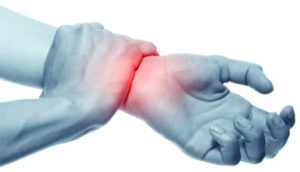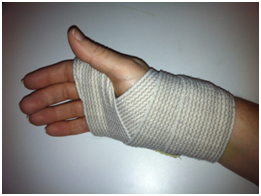 I’ve been gradually developing Carpal Tunnel Syndrome (CTS) for a number of years. For anyone not familiar with CTS, when it starts you often wake up with your thumb and a couple of fingers numb or tingling. I started waking up with my right hand still asleep about 10 years ago. Being fairly ambidextrous, I switched my mouse to my left hand; it relieved my symptoms and amused me greatly whenever IT would stop by to fix something on my computer. About 4 years ago, the tingling and numbness returned, so I started wearing a splint at night, and again, all was good.
I’ve been gradually developing Carpal Tunnel Syndrome (CTS) for a number of years. For anyone not familiar with CTS, when it starts you often wake up with your thumb and a couple of fingers numb or tingling. I started waking up with my right hand still asleep about 10 years ago. Being fairly ambidextrous, I switched my mouse to my left hand; it relieved my symptoms and amused me greatly whenever IT would stop by to fix something on my computer. About 4 years ago, the tingling and numbness returned, so I started wearing a splint at night, and again, all was good.
Until about 6 months ago. At that point, my symptoms changed. I started waking up with a dull ache that I couldn’t “shake out”. Then the aches started to occur during the day too. And then I started to drop things.
This is the classic progression of Carpal Tunnel Syndrome, but having staved off symptoms for nearly a decade, I had to wonder at the sudden and rapid decline. Coincidentally, or perhaps not, about 6 months ago I bought a tablet. I love it. I take it with me to meetings to check email and take notes. It’s usually with me when I’m watching TV in the evening — I browse the internet, check emails, play games — any number of things. If I’m going somewhere sure to have WiFi, there’s a good chance it will be with me. The question that I have to ask myself is, has my tablet use worsened my symptoms or would I have still gotten to this point, this quickly, if I hadn’t bought one?
My tablet weighs about 1.3 lbs (it’s an iPad2). Compared to a laptop or even a netbook, it is far lighter and you would think that it would be better in terms of the ergonomics of use. But I don’t hold my tablet like a laptop. When I use a laptop, it’s usually sitting on a table in front of me or on my lap, freeing my hands for typing. So the only strain on my wrist is caused by holding my hands at a level appropriate for typing. I tend to hold the tablet more like a hardback book – one hand on either side, with the bottom edge resting on something else (a desk, table, my lap) to take the majority of the weight. But because I hold it at an angle for viewing, my wrists still support a great deal of the weight, which causes strain on my wrists. And I have noticed that after using it for a while, my wrists tend to ache.
It used to be believed that repetitive or strain-inducing motions like this lead to CTS, similar in manner to other repetitive stress injuries. More recently there has been debate on this, and the medical community seems to be leaning towards genetic causes and underlying medical issues that increase the risk (see below). However, for those of us predisposed to CTS, it is easy to see how this kind of wrist strain could lead to the onset or worsening of the condition.
CTS is the result of the median nerve being pinched at a point in the wrist. The nerve, along with some tendons, has to pass through a small tunnel in the wrist (the carpal tunnel) that is comprised of bones and ligaments. When the tendons get inflamed, the space for the nerve is compressed, resulting in compression of the nerve itself. Temporary inflammation, like you might experience after shoveling snow or raking leaves, isn’t the problem. Instead, chronic inflammation of these tendons results in chronic compression of the nerve, leading to nerve damage. People with certain medical conditions, like diabetes and hypothyroidism, are more likely to develop this sort of chronic inflammation. Certain tasks, like routinely holding a vibrating tool for hours, also contribute.
So is my tablet to blame for my Carpal Tunnel Syndrome? No. I was predisposed to develop CTS due to other medical concerns. However I do believe my tablet use increased the chronic inflammation I was experiencing, and so may have increased the speed of my wrist’s decline. I’m not going to stop using it, though I may have to change the way that I use it. As technology continues to develop and more hand-held devices enter our lives, we as designers and engineers need to consider the impact that these devices may have on the physical well-being of our users.
Carpal Tunnel Syndrome Info
The median nerve, which supplies movement and feeling to the thumb and the first two fingers, passes through the carpal tunnel in the base of the hand, along with the tendons that connect the fingers to the muscles of the forearm. When the tendons become inflamed, the space is so tight that compression of the nerve results. When that nerve is compressed, the fingers feel numb or tingle. Eventually, chronic compression damages the nerve.
There are certain conditions, like diabetes and thyroid issues that make a person more susceptible to developing CTS, due to their greater susceptibility to chronic inflammation. Repetitive activities involving the hand and wrist, including typing on a keyboard, will contribute to its development as well. Women are also more likely to develop carpal tunnel syndrome, believed to be due to a smaller carpal tunnel.
The primary symptom of Carpal Tunnel Syndrome is numbness, tingling, or itching of the thumb, index, and middle fingers. These symptoms usually first manifest at night, because we have a tendency to sleep with our wrists flexed. If left untreated, eventually the muscle at the base of your thumb may deteriorate, making it difficult to grasp objects.
Visit WebMD for more information on Carpal Tunnel Syndrome.
One final note of caution – I had assumed that since my symptoms weren’t really painful, they weren’t really a problem. I was wrong; don’t make that assumption.
Carpal Tunnel Release Surgery
I wanted to post a quick update, especially in light of one of the comments that brought up Carpal Tunnel Release surgery. Two weeks ago I underwent surgery on my right hand, and it was not what I expected, despite the research I did before deciding on surgery.
First, the surgeon who performed my surgery — an award-winning surgeon with decades of experience who also happens to be the hand consultant for our local professional sports teams — will NOT perform the endoscopic CTS surgery. The reason, told to me by one of his associates, is that the endoscopic surgery does not allow the surgeon to properly see the Transverse Carpal Ligament and the nerves and tendons passing through the Carpal Tunnel, which makes the risk of damage to the nerve or tendons during the surgery greater. I’ve been told by friends in the medical profession that this avoidance of endoscopic surgery seems to be a growing trend in other areas as well. So, if I wanted this amazing surgeon to fix my wrist, I’d have to have open palm surgery. Yikes.
However, my surgeon assured me that the incision would be much shorter than the pictures you’ll see online. Those images made it look like the incision would run from the center of my palm to about an inch past my wrist. My incision is only about an inch long running just over the heel of my hand.
Finally, what I really didn’t expect was to wake up — yes, they knocked me out —  with my hand wrapped in an ace bandage (see image), and being told not to get the bandage wet or to remove it until my follow-up appointment with the surgeon in two weeks. That’s two weeks of one-handed showers with a bag over my hand. Two weeks of not washing dishes (ok, that part wasn’t unpleasant). Two weeks with what eventually became a rather itchy palm. It was a long two weeks.
with my hand wrapped in an ace bandage (see image), and being told not to get the bandage wet or to remove it until my follow-up appointment with the surgeon in two weeks. That’s two weeks of one-handed showers with a bag over my hand. Two weeks of not washing dishes (ok, that part wasn’t unpleasant). Two weeks with what eventually became a rather itchy palm. It was a long two weeks.
Now the physical therapy and scar management starts. I’ll post another update after my hand and wrist have had a chance to heal.
Featured image from | CC BY-SA 4.0
